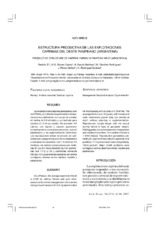Estructura productiva de las explotaciones caprinas del oeste pampeano (Argentina)
Productive structure of caprine farms in pampean west (Argentina)
Autor
Rodríguez-Estévez, V.
Bedotti, D.
Sánchez Rodríguez, M.
García Martínez, Antón Rafael
Gómez-Castro, A.G.
Perea Muñoz, José Manuel
Editor
Universidad de Córdoba, Servicio de PublicacionesFecha
2007Materia
Sanidad caprinaAnálisis sectorial
METS:
Mostrar el registro METSPREMIS:
Mostrar el registro PREMISMetadatos
Mostrar el registro completo del ítemResumen
In La Pampa, the average caprine farm land is 5700 ha, without fences and poor infra-estructure for animal management, there are two farmyards with an area of 5-8 m2/goat and a shed for kids housing with an area of 0.15 m2/kid. The average flock size is 164 goats, with horses and catle, extensively grazed daily and penned at nigth, without planning or suplementation. Reproducers usually began with the sexual activity before to have an apropiate weight. Kidding peaks occurs between end of september and middle of november. The number of bocks is 1-3/100 female. Reproductive parameters are: fertility 97,3 percent; fecundity 89,4 percent; real prolificity 177,2 percent and comercial prolificity 160,6 percent. Major health problems were contagious ectima, diarrhoea in kids, mastits and pediculosis. Las explotaciones caprinas pampeanas, son de 5700 ha, sin delimitación perimetral e infraestructura muy deficiente, con un par de corrales sin techar de 5-8 m2/cabra y uno techado para cabritos (0,15 m2 por cabrito). En promedio 164 cabras, con equino y vacuno, pastorean extensivamente, con encierro nocturno, casi sin planificación y sin suplementación alimenticia. Los reproductores entran en servicio sin suficiente peso y la paridera va de fin de septiembre a mediados de noviembre. Con 1-3 machos/100 hembras, los índices reproductivos son: fertilidad 97,3 p.100; fecundidad 89,4 p.100; prolificidad real 177,2 p.100 y prolificidad comercial 160,6 p.100. Los problemas sanitarios son ectima contagioso, diarrea de los cabritos, mastitis y pediculosis.

